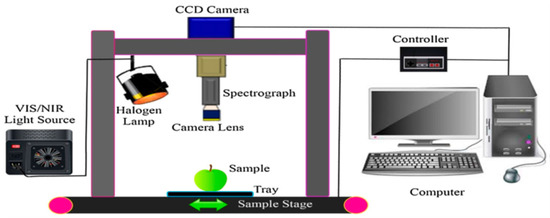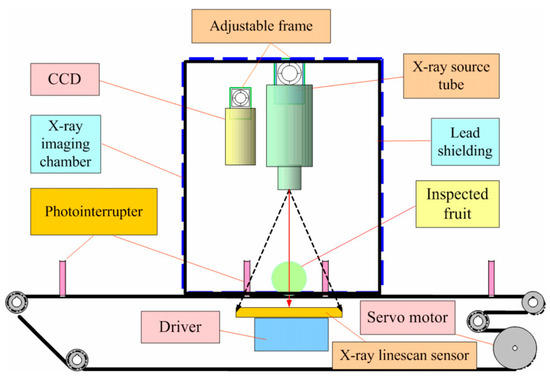There has been a lot of attention devoted to developing new technologies that can improve the detection of insect infestation in fruits and vegetables under postharvest conditions using a multitude of non-destructive technologies in the last few years. The motivation stemmed from challenges in preventing insects of quarantine significance from getting into the supply chain, the economic benefits that ensue from having efficient detection systems, and the availability of improved technologies in this domain that encouraged studies that have produced efficient solutions. This review presents a general overview of current non-destructive techniques for the detection of insect damage in fruits and vegetables and discusses basic principles and applications. We also elaborated on the specific post-harvest fruit infestation detection methods, which include principles, protocols, specific application examples, merits, and limitations. The methods reviewed include those based on spectroscopy, imaging, acoustic sensing, and chemical interactions with greater emphasis on the noninvasive methods. This review also discusses the current research gaps as well as the future research directions for non-destructive methods’ application in the detection and classification of insect infestation in fruits and vegetables
1. Definition
In the last two decades, food scientists (engineers) have attempted to develop new technologies that can improve the detection of insect infestation in fruits and vegetables under postharvest conditions using a multitude of non-destructive technologies. While consumers’ expectations for higher nutritive and sensorial value of fresh produce has increased over time, they have also become more critical on using insecticides or synthetic chemicals to preserve food quality from insects’ attacks or enhance the quality attributes of minimally processed fresh produce. In addition, the increasingly stringent quarantine measures by regulatory agencies for commercial import–export of fresh produce needs more reliable technologies for quickly detecting insect infestation in fruits and vegetables before their commercialization. For these reasons, the food industry investigates alternative and non-destructive means to improve food quality. Several studies have been conducted on the development of rapid, accurate, and reliable insect infestation monitoring systems to replace invasive and subjective methods that are often inefficient. There are still major limitations to the effective in-field, as well as postharvest on-line, monitoring applications. The future of non-destructive testing will be enhanced by the current trend in IoT, big data science, and machine learning analysis.
2. Introduction or History
In recent years, there has been significant growth in the consumption of fruits and vegetables, which can be attributed to several factors, among which is increased awareness of their health benefits [
1]. Consumers, especially the “Generation Z” (post-millennial with ages between 11 and 23 years) that constitute about 32% of the US population, are more cognizant of what they eat and many of them tend to eat healthy, often preferring organic foods [
2]. The easy access to information through smart devices has also increased the understanding of consumers on what they eat, and many more people, beyond the younger generations, are tending toward more natural, minimally processed, and organic food. This demand is driving the trend for high-quality, consistent, and safe products at a reasonable price [
3]. The agricultural production sector and the food industry as well as the safety agencies are saddled with the responsibility to meet these increasing demands for produce with low-toxicity pesticides. In order to be efficient in meeting quality and demand, there is a need to replace destructive and off-line conventional quality assessment methods with rapid, non-invasive, environmentally friendly, and accurate methods for quality assessment and safety assurance [
4].
Insects cause enormous damage to fruits and vegetables each year, leading to major production and economic losses in the agricultural production and food industry worldwide. Insect pests are considered to be responsible for approximately 10–20% of yield losses in major crops worldwide, and even far more in developing countries, reaching about 50% of annual horticultural production in Africa, which is a $22.5 billion industry [
5]. The havoc caused by insect pests in trans-border trade, with increased global trade network, is enormous. The detection of these insect pests before they get into the supply chain is still a major challenge for the industry. The US loses about $40 billion yearly because of these organisms of quarantine concern [
6,
7]. On the other hand, insect pests such as budworms are hard to control [
8]. Insect feeding often cryptically occurs within fruits and vegetables without showing an obvious external symptom until they are nearly fully rotten. This is the case of the codling moth (
Cydia pomonella, Lepidoptera: Tortricidae), one of the most devastating pests in apples. This insect has four main stages in its life cycle, egg, larva, pupa, and adult moth [
9]. The larval phase is its most devastating phase when it feeds on the flesh and pulp of fruits it was laid on. When the point of entry is the calyx, the damage is difficult to detect with the subjective method of assessment common in most apple processing plants and this is why non-destructive detection becomes important [
9,
10]. Early detection when eggs are laid on the surface of the produce is also very important.
In order to prevent the economic and ecological losses from alien insect pests, increasingly stringent quarantine measures are being put in place by governments. As an example, Fruits and Vegetables Import Requirements (FAVIR) of the US government require preclearance of horticultural consignments in the exporting countries as well as inspections at the ports of arrival for any live larva or pupa of quarantine pests. In general, a biometrically designed statistical sampling is applied to conduct phytosanitary physical inspections against any quarantine-significant insect in fruits and vegetable commodities. In 2017, around 194 million pounds of fresh fruits and vegetables were inspected and cleared for shipment to the United States [
11]. Based on the United States Department of Agriculture (USDA) report about the US plant inspection stations in 2017, the inspection of plant materials is mostly conducted physically, along with some modern technologies such as digital imaging, X-ray and molecular detection tools for low-volume plants, plant cuttings, and seeds. As a result, automatic, fast, and reliable noninvasive methods of detection are needed to monitor quarantine pest existence and the internal quality of the fruits and vegetables in high-volume shipments [
12].
The rapid advancement in electronic technology and data analytics with greater computing power, along with their increased application in the agricultural field, have introduced new methods for non-destructive quality assessment of fruits and vegetables. A range of techniques have been reported for non-destructive detection of insect infestation such as near-infrared (NIR) spectroscopy [
13,
14,
15,
16], acoustic methods—sound/noise/vibration [
17,
18,
19], imaging—visible light sensing [
20], hyperspectral imaging [
3,
21], nuclear magnetic resonance [
22], X-ray [
23,
24], volatile emission, and others [
25,
26,
27,
28]. With these new applications of technology in agricultural processing as well as the multiplicity of investigations all over the world, up-to-date reviews are needed as an orientation over technological applications in agriculture and food science. There are currently few reference papers reviewing some of the state-of-the-art works in non-destructive quality assessment of fruits and vegetables. Particularly, no review is available focusing on recent postharvest non-destructive methods for the detection of insect infestation in fruits and vegetables. Thus, this paper reviews all known techniques used for postharvest non-destructive detection of internal insect infestation in fruits and vegetables: their basic principles of operation are explained, the merits, as well as the limitations of each method are profiled, several examples of applications are presented, and challenges and opportunities for the future are discussed.
3. Applications and classification
3.1. Spectroscopic Techniques
Spectroscopy methods provide operational information about the chemical and physical characteristics of fruits and vegetables by obtaining reflectance, transmittance, absorbance, or scattering of polychromatic or monochromatic radiation from the surface of the sample in the ultraviolet (UV), visible (Vis), and NIR regions of the electromagnetic spectrum. But, the application of NIR region (780 to 2500 nm) is particularly compelling because it is sensitive to overtones and combinations of chemical bonds such as C–H, O–H, and N–H, which are abundantly present in foods. Moreover, NIR spectroscopy has the capacity of measuring multiple quality attributes of foods simultaneously [
28]. Some researchers have proven the high potential of NIR spectroscopy for the detection of insects or insect damage in food commodities, such as blueberries [
14], cherries [
31], figs [
32], green soybeans [
33], jujubes [
16], chestnuts [
34], and other foods [
25,
26,
27,
35].
3.2. Visible Light Sensing
In the last four decades, machine vision systems have been extensively investigated to replace the human role in several agricultural applications, including sorting, detecting defects and diseases, and characterizing other quality attributes of agricultural products [
38,
39]. Visible light sensors at a wavelength from 380 to 750 nm falls in the range that is generally used for detecting external or surface features [
8].
Table 1. Studies on detection of insect infestations in fruits and vegetables using visible color cameras.
| Sensor Type |
Crop |
Insect Type |
Machine Learning Technique |
Classification Results |
Reference |
| RGB camera |
Citrus |
Scale insect (Coccoidea) |
MIA |
92.8% |
[43] |
| RGB camera |
Citrus |
Thrips (Thysanoptera), Scales, and Medfly (Ceratitis capitata) egg |
BDA |
73–86% |
[42] |
| RGB camera |
Citrus |
Medfly |
BDA |
NA |
[45] |
| RGB camera |
Citrus |
Thrips, Scales, and Medfly egg |
ROSA |
93.4–100% |
[41] |
| RGB camera |
Citrus |
Thrips, Scales, and Medfly egg |
LDA |
43.2–78.1% |
[40] |
| Line scan cameras |
Pistachio |
Insect damage |
DF |
74–91.8% |
[46] |
This entry is adapted from the peer-reviewed paper 10.3390/foods9070927


